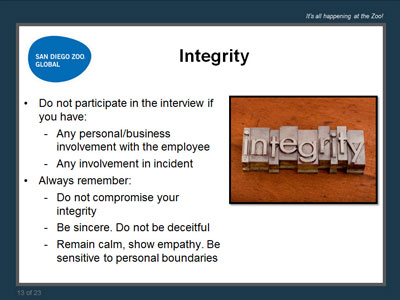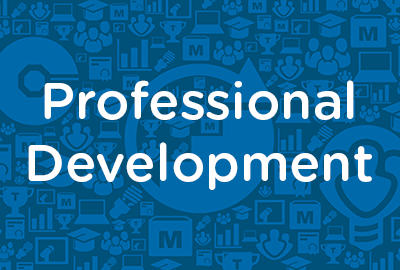 |
Sales Management: Managing Sales Territories |
0.50 |
This course will focus on identifying the steps for choosing the best territory strategy and identifying the factors to consider when conducting territory reviews. |
 |
Project Management - Intermediate: Risk Identification and Management |
1.00 |
This course will cover how to classify project risks and identify risk management goals and how to identify the steps in the risk management process, design a risk management plan, and identify key issues that a risk management plan must address. You will also learn how to identify common sources of risks and tools you can use to help in the identification process, and describe and classify risks once they are identified. |
 |
Engaging Your Employees in a World Famous Way |
1.00 |
Engaged employees are not just committed. They are not just passionate or proud. They have a line-of-sight on their own future and on the organization's mission, vision, and goals. They are "enthused" and "in gear," using their talents and discretionary effort to make a difference in their employer's quest for sustainable business success. Join us for this ENGAGING webinar on how the World Famous San Diego Zoo proactively turned Employee Engagement into a top organization objective - with stunning results! |
 |
Generational Differences - Managing The Complexity |
1.00 |
Could dealing with people get any more difficult? Today’s business environment brings many challenges with four different generations working together for the first time. Communication, respect, recognition, retention, interaction with others, and work life balance mean something different to each generation. If not understood and managed effectively workplace conflict, poor communication, low morale, and high turnover can occur. Understand and discover the key values and contributions among these four generations. Each generation provides intrinsic value to an organization. You will learn how to capitalize on the strengths of the Traditionalists, the Baby Boomer’s, Generation X, or the Millennial Generation (Gen Y). By implementing effective strategies for communication, recognition, development, retention, and leadership you will uncover the hidden talents of each generation while minimizing the risk of knowledge transfer. You will learn the key generational differences and similarities in each of these areas. Join us as we share with you some of the many generational challenges in today’s work environment. |
 |
Conducting World Class Employee Investigations |
1.00 |
Employment litigation and claims in recent years have cost employers billions of dollars. Employers must find ways to reduce their vulnerability to such claims. Often times, employer liability hinges on the quality of the company's investigation into complaints of discrimination, harassment, or other claims of workplace misconduct. In fact, an important consideration in an employee's decision to ultimately file a lawsuit or claim is whether the employer conducted an effective workplace investigation. Join San Diego Zoo Global's Associate Director of Human Resources for a dynamic and informative workshop on how to conduct effective workplace investigations that will protect your organization and reduce potential litigation costs. This comprehensive webinar will include a discussion about:
- A step-by-step approach on how to plan and conduct workplace investigations
- A practical demonstration of effective interview techniques
- How to anticipate and respond to legal and practical issues that frequently arise during the course of investigations
- Preparing bullet-proof documentation to support the investigation findings and recommended actions |
 |
Business Accounting: Time Value of Money |
1.00 |
This course will cover how to calculate the present and future values of a cash flow as well as how to calculate the interest rate and the maturity date of a security by using the time value of money equation. You will also learn how to calculate the present and future values of ordinary annuity and annuity due and the present and future values of bonds. |
 |
Change Management: Obstacles to Change |
0.75 |
This course will cover how to identify the causes of resistance and the negative reactions to change and the methods for managing them. You will also learn how to identify the causes of complacency and prepare for crisis. |
 |
Creativity and Innovation: Promoting Team Creativity |
1.34 |
The purpose of a team is to bring together people with diverse personalities, knowledge, education, and experience. This combined diversity encourages creativity and productivity to accomplish a common goal. Teams might consist of people from a single department or several departments.
Teams can generate new ideas, expand on or improve current ideas, make decisions, and solve problems. Teams can also be assigned to a specific task or be made responsible for a broader area, such as responding to changing customer expectations. When team members recognize their roles in a team, and the manager performs his responsibilities, creativity has a better chance of flourishing.
In this course you will learn to: identify characteristics of creative teams, and manage these teams effectively, conduct creative team sessions, and conduct brainstorming sessions, and use creativity to solve problems. |
 |
Grammar Skills: Word Choice |
1.00 |
This course covers how to choose the appropriate words for clear communication and how to recognize and use frequently misused words correctly. You will also learn how to avoid common spelling errors and correctly attach prefixes and suffixes to words. |
 |
Cross-Cultural Business Communication: Addressing Cross-Cultural Issues |
1.00 |
When communicating with coworkers, it is very important to respect other cultures. You should refrain from using humor that might offend people from other cultures, and avoid stereotypes that might affect how you treat your coworkers.
Before communicating with employees who belong to a different culture, it is important to research their cultures and understand clearly what is expected from your communication. You should determine what types of communication are most appropriate in specific situations. For example, you should investigate the most appropriate method for communicating a behavioral problem to an employee. Some cultures prefer profuse praise to cushion the constructive feedback, while others prefer a more direct approach. The most important thing to communicate to employees of different cultures is respect. By approaching them in accordance with their cultural standards and expectations, you’ll show respect for their cultures and your communication will be enhanced.
In this course you will learn to: identify gestures used in different cultures and build a cross-cultural team, and discuss guidelines for writing cross-cultural documents and assembling a translation team. |
 |
Cross-Cultural Business Communication: Communicating Across Cultures |
1.00 |
When communicating across cultures, you could come across a number of barriers. In addition to language barriers, there might be more subtle obstacles, such as cultural biases and conflicting communication styles. Building relationships with people of other cultures will provide you with the incentive to work through those barriers and achieve effective communication.
In this course you will learn to: establish rapport and build trust, and listen well and provide positive and constructive feedback. |
 |
Customer Service: Customer Service Skills |
1.00 |
A great customer service representative should have skills in three key areas: organization (time and stress management), motivation (letting customers know you care), and communication (vocal, verbal, and visual). The core strength of a good customer service rep is sound knowledge of the organization’s products and services. |
 |
Customer Service: Customer Service Basics |
0.75 |
It is amazing how much time, effort, and money is invested in sales education. However, customer service is not given the same level of resources. If you think about selling as a process, the final phase is not closing the sale, it’s serving the customer. After an effective sales process awards you a new customer, it is customer service that will determine whether your customer stays with you. |
 |
Cultural Competence |
0.33 |
Culture reflects belief systems, practices, and the products of beliefs and practices among groups of people. This Cultural Competence training course is designed for participants to engage, reflect, and apply the information provided. |
 |
Sales: Prospecting |
0.75 |
In this course, you will learn how to define your target market and customers for effective prospecting, how to identify various prospecting methods that can be used to obtain leads and sales, and how to develop a script for phone calls. |
 |
Project Management - Basic: Project Initiation and Scope Planning |
1.00 |
This course will cover how to initiate a project, identify project deliverables, use effective project selection methods, identify project constraints, and write a project charter. This course will encourage you to create a scope statement, create a statement of work, and follow a scope management plan to prevent scope creep. |
 |
Grammar Skills: Synonyms, Antonyms, and Homonyms |
0.25 |
This course covers how to differentiate between synonyms and antonyms. You will also learn how to use homonyms and recognize the differences between various homonyms. |
 |
Budgeting: Budgeting Fundamentals |
1.33 |
A typical budget contains information for a single year and is updated and revised periodically. Each company creates a budget that fits its unique needs. A budget can be used for many purposes, but its primary functions should be to support strategic goals and to help identify when actual results deviate from what was predicted. |
 |
Creativity and Innovation: Fostering A Creative Environment |
1.00 |
Creativity is the ability to look at a situation from every possible angle and determine potential ideas, solutions, or outcomes. Employees with this ability add value to an organization by increasing its efficiency and productivity. This is why board members, stockholders, managers, and other employees want to recruit and retain creative individuals. Everyone in an organization benefits from the recruitment of creative people.
When a candidate begins to search for a job or becomes aware of available positions, the candidate will form an opinion about your company based on promotional material, media articles, stories, and word-of-mouth. Creative people look for flexibility. Although managers might hire creative people, some managers still tend to stifle employees’ creativity with excessive rules and directions. Creative candidates must believe that they will have the flexibility to be innovative, or they will look elsewhere for employment.
In this course you will learn to: recruit and retain creative individuals, and maintain a creative environment. |
 |
Organizational Communication: Communication Basics |
1.25 |
Good internal and external communication is crucial to any organization’s success.
In this course you will learn to: communicate effectively, define the theories of management, identify organizational types and characteristics, and plan communication flow. |
 |
Team Participation: Communicating in Teams |
0.50 |
This course will focus on how to understand the factors affecting team communication, understand the elements of communication and use verbal communication, and communicate supportively and effectively. |
 |
Call Center Management: Managing for Excellent Service |
1.00 |
This course will cover how to set service levels, achieve service levels, and use reports. |
 |
Sales: Qualifying |
0.50 |
In this course, you will learn how to improve your listening skills to better understand customers’ needs and decision-making criteria. You will also learn how to use questioning techniques to help customers recognize the benefits of your products and services. |
 |
Project Management - Basic: Scope Definition, Verification, and Change Control |
1.50 |
This course will cover how to identify the process and benefits of scope definition and verification, and develop a work breakdown structure (WBS) and work package. You will also learn how to identify the types of information that stakeholders need in order to verify a project’s scope, and determine the timing of scope verification. You will be able to better understand how to control changes in project scope, identify the benefits of a scope change control system, and describe why it’s important to create a project database. |
 |
Business Ethics: Unethical Behavior |
1.00 |
In this course you will learn to: recognize the sources of unethical behavior, and take action to prevent it, and end unethical behavior by conducting an intervention meeting, and promote ethical behavior in the workplace. |


























